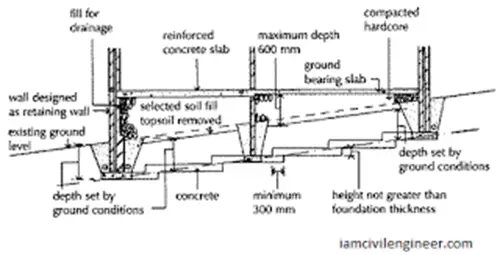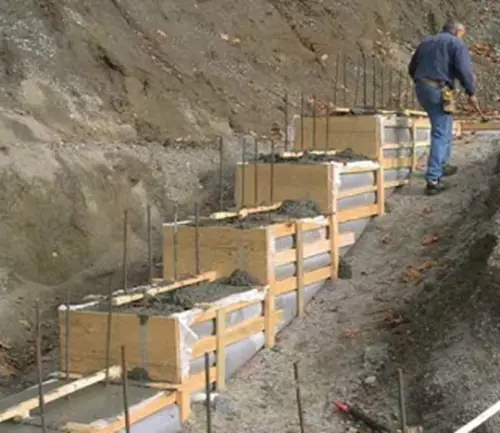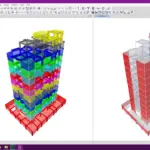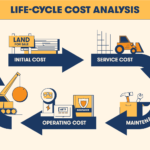If you have ever stood on the side of a hill and looked at houses built on the same lot, you would notice that one home might be significantly smaller than the other home just because of the way the foundation was built. There are ways to build houses on sloping lots to ensure that everyone gets an equal amount of land in their property.
Have you ever considered purchasing a house on a slope? If you’re interested in this type of property, you may be wondering if it makes sense to build the house on steps rather than level ground.
If you’re building on a sloping lot, it may be necessary to use a stepped foundation in order to achieve proper grade, avoid settling problems, and maintain structural integrity.
And this article will show you how to build your home with stepped foundations, so you can maximize the use of your lot and enjoy more space inside your home.
Also Read: What is Raft Foundation?

Stepped foundation – The building blocks of your home on a sloping lot
The natural surface of ground is not always level and mostly to such an extent that there may be a considerable slope either across or along or both across and along the site of most buildings.
Where the ground floor is to be at or just above ground level at the highest point, it is necessary to import some dry fill material such as broken brick or concrete hardcore to raise the level of the over site concrete and floor. This fill will be placed, spread and consolidated up to the external wall once it has been built.
Also Read: Dry Mix Concrete Plant
To economize and expend less in excavation and foundation walling on sloping sites where the subsoil, such as gravel and sand, is compact it is practice to use a stepped foundation, which contrasts diagrammatically the reduction in excavation, and foundation walling of a level and a stepped foundation.
Like Us on Facebook!

What is a stepped foundation?
A footing in which the desired width is secured by a series of steps in about the proportion of one unit of horizontal dimension to two units of vertical dimension.
Subscribe Us on YouTube!
A foundation constructed in a series of steps that approximate the slope of the bearing stratum. The purpose is to avoid horizontal force vectors that might cause sliding.

On sloping sites an initial decision to be made is whether the ground floor is to be above ground at the highest point or partly sunk below ground.
Homeowners want to build a house, but the space they live in is too steep to use traditional methods of laying concrete and placing it on foundations.
When this occurs, they might find that the best way to create their new home is by using a stepped foundation, or terraced construction.
By staggering the height of each level downward, you can create the needed amount of structure and ensure safety for those living in and around the house.
But there are pros and cons to all approaches that need to be considered carefully before beginning any construction process.
Also Read: Lean Concrete – Base – Mix Design – Strength – Purpose – Uses
Construction process
The foundation is stepped up the slope to minimize excavation and walling below ground. The foundation is stepped so that each step is no higher than the thickness of the concrete foundation and the foundation at the higher level overlaps the lower foundation by at least 300 mm.

The load bearing walls are raised and the foundation trenches around the walls back-filled with selected soil from the excavation. The concrete over site and solid ground floor may be cast on granular fill no more than 600 mm deep or cast or placed as a suspended reinforced concrete slab. The drains shown at the back of the trench fill are laid to collect and drain water to the sides of the building.
Pros
Benefits of using stepped foundation on slope rather than spending money on making it level. Here are just some of the benefits of having a stepped foundation:
- It allows you to build up the house gradually in an environment-friendly way by utilizing materials that would be too steep or expensive to transport.
- Your foundation can act as additional storage space below grade. It also can act as crawl space in extreme climates, where insulation is needed and flooding is not anticipated. –
- Generally, steps will have less concrete poured than one level. As concrete prices rise, this can become significant savings over time.
- Stepped foundations also make for good drainage, which prevents water from pooling around the perimeter of your house.
- Also Read: Concrete forms – Tips for formwork construction
Disadvantages
Using a step foundation does require more excavation work because excavators need to go down several levels before they start building upward. Stepping may increase material costs (as each layer requires its own footing).


















